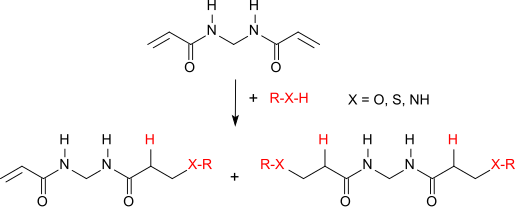This is the current revision of this page, as edited by Photocyte (talk | contribs) at 23:26, 12 May 2023 (Add bis as "other names"). The present address (URL) is a permanent link to this version.
Revision as of 23:26, 12 May 2023 by Photocyte (talk | contribs) (Add bis as "other names")(diff) ← Previous revision | Latest revision (diff) | Newer revision → (diff) Chemical compound, polyacrylamide crosslinker "MBAm" redirects here. For the computer software, see Malwarebytes' Anti-Malware. For the museum, see Montreal Museum of Fine Arts.
| |

| |
| Names | |
|---|---|
| Preferred IUPAC name N,N′-Methylenedi(prop-2-enamide) | |
| Other names bis | |
| Identifiers | |
| CAS Number | |
| 3D model (JSmol) | |
| ChemSpider | |
| ECHA InfoCard | 100.003.411 |
| EC Number |
|
| MeSH | C021221 |
| PubChem CID | |
| UNII | |
| CompTox Dashboard (EPA) | |
InChI
| |
SMILES
| |
| Properties | |
| Chemical formula | C7H10N2O2 |
| Molar mass | 154.169 g·mol |
| Appearance | white solid |
| Melting point | 181–182 °C (358–360 °F; 454–455 K) |
| Except where otherwise noted, data are given for materials in their standard state (at 25 °C , 100 kPa).
| |
N,N′-Methylenebisacrylamide (MBAm or MBAA, colloquially "bis") is the organic compound with the formula CH22. A colorless solid, this compound is a crosslinking agent in polyacrylamides, e.g., as used for SDS-PAGE.
Synthesis
Acrylamide reacts with an aqueous solution of formaldehyde in the presence of copper(I) chloride as a polymerization inhibitor and sulfuric acid as catalyst to form N,N′-methylenebisacrylamide with yields of 60 to 80%.
The reaction proceeds via N-hydroxymethylacrylamide, which can be detected in alkaline solution and decomposes in acid to give N,N′-methylenebisacrylamide. Using acrylamide and paraformaldehyde in 1,2-dichloroethane gives a clear solution upon heating, from which MBA crystallizes.
In aqueous media, acrylonitrile also reacts with formaldehyde to give crude N,N′-methylenebisacrylamide, which can be purified by recrystallization with acetone/water.
Reactions and uses
Under basic conditions, MBA reacts further with formaldehyde at the amide nitrogen to give N-hydroxymethyl,N,N′-methylenebisacrylamide. Nucleophiles such as alcohols, amines, or thiols add across the activated vinyl groups, giving mixtures of mono- and disubstituted products.
As a bifunctional electron-poor dienophile, MBA reacts with electron-rich dienes, such as cyclopentadiene, in Diels–Alder reactions, giving the corresponding norbornene adducts.
As a symmetric, unconjugated divinyl monomer, MBA can be used with suitable initiators in cyclopolymerizations to create linear, soluble polymers whose backbones are built from five- and seven-membered rings. With acrylic and vinylic monomers such as acrylonitrile, acrylamide, and substituted acrylamides, MBA can undergo radical copolymerization to form highly crosslinked gels, using peroxides, UV light, or redox initiators.
The properties of such gels are determined by the crosslink density, and targeted gel formation using MBA crosslinking gives useful technical properties used in various applications, such as in adhesives, paints, and superabsorbents. In biochemistry, MBA is used for chromatography gels and polyacrylamide gel electrophoresis.
See also
References
- Yuan-na Sun; et al. (2014). "Super Tough, Ultrastretchable, and Thermoresponsive Hydrogels with Functionalized Triblock Copolymer Micelles as Macro-Cross-Linkers". ACS Macro Letters. 3 (5): 496–500. doi:10.1021/mz500221j. PMID 35590790.
- Paez, Julieta I.; Farrukh, Aleeza; Ustahüseyin, Oya; Del Campo, Aránzazu (2018). "Biofunctionalization of Poly(acrylamide) Gels". Biomaterials for Tissue Engineering. Methods in Molecular Biology. Vol. 1758. pp. 101–114. doi:10.1007/978-1-4939-7741-3_8. ISBN 978-1-4939-7739-0. PMID 29679325.
- US 2475846A, "Alkylidene-bis-acrylamides", issued 1946-10-31
- H., Petersen. Methods of Organic Chemistry, Vol. E20. p. 1855. ISBN 978-3-13-219004-7.
- Magat, Eugene E.; Faris, Burt F.; Reith, John E.; Salisbury, L. Frank (March 1951). "Acid-catalyzed Reactions of Nitriles. I. The Reaction of Nitriles with Formaldehyde 1". Journal of the American Chemical Society. 73 (3): 1028–1031. doi:10.1021/ja01147a042. ISSN 0002-7863.
- Okada, Yukinori; Tanaka, Fumihiko (May 2005). "Cooperative Hydration, Chain Collapse, and Flat LCST Behavior in Aqueous Poly( N -isopropylacrylamide) Solutions". Macromolecules. 38 (10): 4465–4471. Bibcode:2005MaMol..38.4465O. doi:10.1021/ma0502497. ISSN 0024-9297.
- Behari, Kunj; Agrawal, Uma; Das, Rima (October 1993). "Gel Free Polymerization of N,N′-Methylenebisacrylamide Initiated by a Peroxodiphosphate-Thioacetamide Redox System. A Kinetic Study". Polymer Journal. 25 (10): 1007–1013. doi:10.1295/polymj.25.1007. ISSN 0032-3896. S2CID 95392705.
This article about an alkene is a stub. You can help Misplaced Pages by expanding it. |



